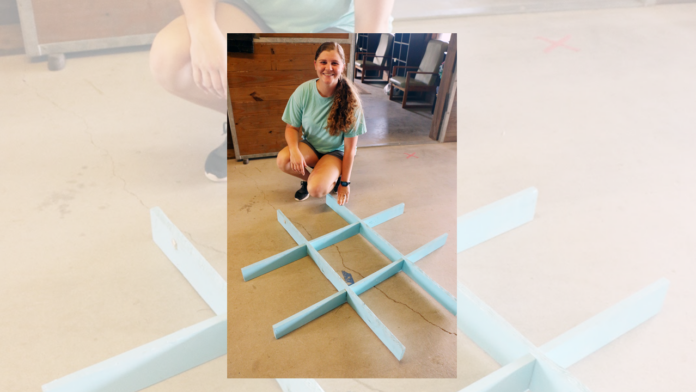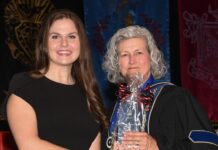
HANCEVILLE, Ala. – COVID-19 has created all manner of hardships for professionals in medical service, but also for those working to get into the field. Medical students are required to put in a certain number of clinical or fieldwork hours for graduation and certification, but current restrictions have made access to many traditional sites like hospitals and nursing homes difficult or even impossible in many instances. Wallace State Community College (WSCC) Occupational Therapy Assistant (OTA) faculty and students decided to think outside the box and find new avenues for the eight weeks of required field experience and opportunities to do some good for others along the way.
WSCC Assistant to the President for External and Cultural Affairs Kristen Holmes said, “When COVID hit, there were not enough traditional fieldwork placements for all of our students in the OTA program. Luckily, our OTA program director was able to create some fieldwork placements in areas that did not currently have OTA, but were a good fit for the skills that we provide from our program. We call these ‘emerging practice areas.’ Our teachers provided the supervision for these students and they are taking place at several community sites in and around Cullman.”
What do Occupational Therapy Assistants do?
According to WSCC, occupational therapy assistants work under the direction of occupational therapists to provide rehabilitative services to persons with mental, physical, emotional or developmental impairments. The ultimate goal is to improve clients’ quality of life and ability to perform daily activities. For example, occupational therapy assistants help injured workers re-enter the labor force by teaching them how to compensate for lost motor skills or help individuals with learning disabilities increase their independence. OTAs are employed in hospitals, rehabilitation centers, nursing homes, home health agencies, private practices and other specialized health care settings.
Creative fieldwork
The sites for WSCC’s OTA fieldwork included: Hope Horses Therapeutic Riding, The Link of Cullman County, Youth Advocate Program and Flourish of Cullman.
OTA Program Director Laura Smith called the four local sites “places that have programs existing, that don’t have occupational therapy in them, but could benefit from the skills and knowledge that our students have.”
According to Smith, students were able to excel in new kinds of environments because of a program focus that goes beyond physical disabilities.
Said Smith, “We’re a very holistic practice: we look at the person not just physically, but mentally. We look at what motivates people, what drives people, what goals they want to work on. Our students at Flourish have been helping with job coaching and life coaching, and identifying skills of these participants in that program, and see what they want to do, and then they’ve been helping them with all those things. It’s been a really great fit there.”
At The Link, among other things, according to Smith, students helped with the Kindergarten readiness camp, “to teach skills that an occupational therapist just fits right in with, because social skills and fine motor skills- cutting, tracing, drawing- those are things that an occupational therapy assistant would do in a pediatric clinic typically, you know. It’s been an amazing fit there.”
Smith said the students led anger management and parenting classes at The Link, and even helped build a fence to create an outdoor space where children can play during supervised parental visits.
At Hope Horses the staff works with clients who are developmentally or physically disabled, doing things that Smith said fall right into the area of OTA: “They teach balance on a horse, left and right- identifying left from right, grip- holding onto the reins of the horse. Well, all of those are skills that our students learn how to take something and facilitate it and make it better.”
WSCC OTA students worked with the Hope Horses staff to improve their existing programs and to develop new strategies for serving their clients.
At the Youth Advocate Program, the students worked with at-risk students on anger management, stress management, building self-esteem, “Kind of on that holistic side again, kind of that mental health,” said Smith, “because, really, the purpose of occupational therapy is to help people be as independent as possible in whatever way it’s being limited. It could be that it is a physical limitation, and that’s where most of our traditional sites deal more with physical things; you know: nursing homes, hospitals, outpatient clinics. But occupational therapy actually started in mental health back to the first World War, so that’s really kind of where we started. So being able to kind of get back to those roots in these settings has been really cool.”
Smith said that last year’s changes in Medicare reimbursement policies and the home health industry caused uncertainty in the OTA field, uncertainty that was only compounded by COVID-19 shutdowns.
Smith said she told her students, “‘I want you to realize that the skills that you have can be utilized in a variety of settings. It doesn’t have to be a setting where occupational therapy already exists. Think about the skills that you’ve learned.’ They’ve learned so many skills: they know how to lead groups, they know how to look at an activity and modify it for someone who wants to do it independently, whether they’ve had a change to their body- they’ve had an amputation or they’ve had an injury, and that puts them in a wheelchair, on a walker- and they still want to do something independently. We have the skills to take that and modify that, and help them be able to participate in that activity safely and independently.
“They can utilize those skills in a variety of places. That’s something I’ve been kind of pushing for them: to advocate for themselves, to look for jobs that may not be in a traditional setting, because we don’t know, really, where traditional jobs are going to be for a little bit.”
Smith said that employment trends in traditional OTA are ticking back up, but she still wants students to be prepared to think and act creatively.
“I think they have really enjoyed being in these emerging practice settings, because they got to see that, yeah, their skills just fit in greatly at these places. And the facilities have just jumped with joy at having them there; they say they’re so hard-working, they know so much and they come in just ready and eager to work and create. They’ve just made so many projects and created all these activities, and they’re really taking their skills and then handing over resources that these facilities can then utilize and run with. It’s just been a beautiful fit for both sides.”
For more on the Wallace State OTA program, visit www.wallacestate.edu/programs/health-division/occupational-therapy-assistant.
Copyright 2020 Humble Roots, LLC. All Rights Reserved.





























